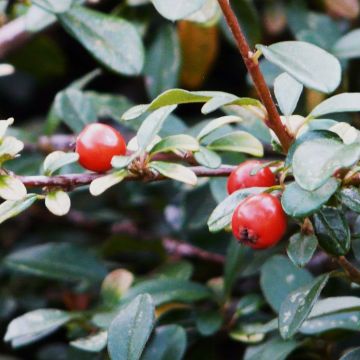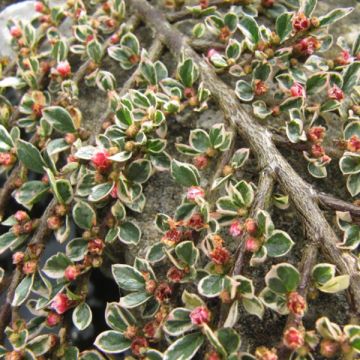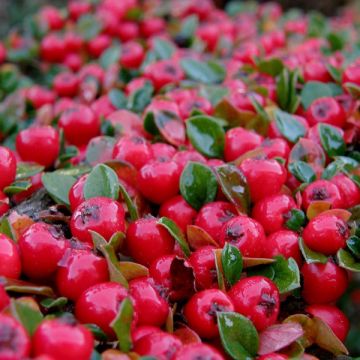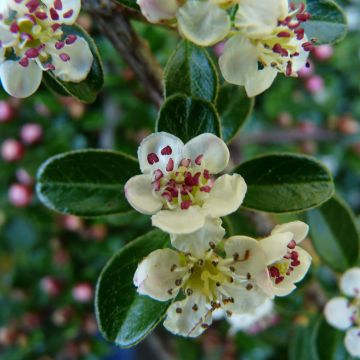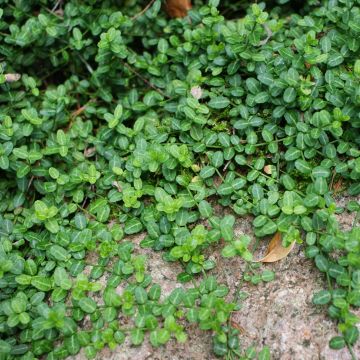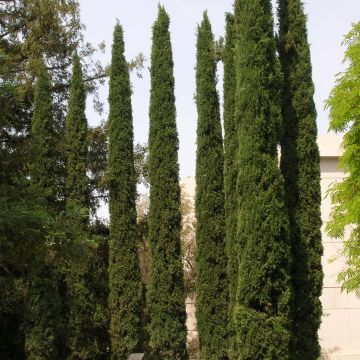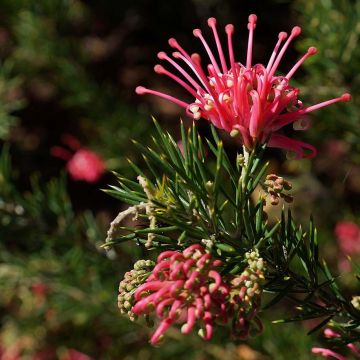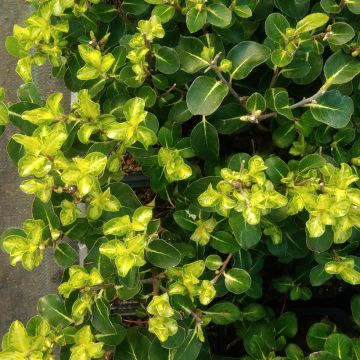

Cotoneaster adpressus
Cotoneaster adpressus
Cotoneaster adpressus
Creeping Cotoneaster
This item cannot be shipped to the selected country
Delivery charge from €6.90
More information
Delivery charge from €6.90
More information
Schedule delivery date,
and select date in basket
This plant carries a 24 months recovery warranty
More information
We guarantee the quality of our plants for a full growing cycle, and will replace at our expense any plant that fails to recover under normal climatic and planting conditions.
From €7.90 for pickup delivery and €6.90 for home delivery
Express home delivery from €8.90.


Does this plant fit my garden?
Set up your Plantfit profile →
Description
Cotoneaster adpressus is a vigorous creeping bush, with strong growth, forming a remarkably dense ground cover. Its deciduous foliage is light green and vibrant in spring, darkening somewhat in summer before turning a beautiful red in autumn. Its small white flowers tinged with red give way to bright red berries in summer, which are quite decorative. Its very dense vegetation limits the appearance of weeds on slopes and covers the ground at the base of larger shrubs. Like many Cotoneasters, it is very undemanding in terms of soil and exposure and is suitable for all styles of gardens.
Cotoneaster adpressus belongs to the Rosaceae family. It is native to western China, where it grows in mixed forests that cover rocky slopes of mountains, at an altitude between 1900 and 4000 m (6233 ft 7 in and 13123 ft 5 in). This bush has been praised in England by the Royal Horticultural Society for its ornamental qualities and performance in the garden. It is very robust and capable of withstanding very harsh winters and occasional droughts, even when growing in poor, rocky soil. It has a prostrate, spreading and creeping habit, supported by curved and flexible, irregular, reddish-brown, branches, hairy when young, then greyish to almost black and smooth as they age. Its growth is quite rapid, reaching a height of about 35-40 cm (13.8-15.7 in) with a spread of 2 m at maturity. Its deciduous foliage consists of small, thick and leathery leaves, ovate in shape, not exceeding 1.5 cm (0.6 in) in length and 1 cm (0.4 in) in width. They are light green when they emerge, darken over time, and turn red in autumn before falling. Flowering occurs in May, with very small, nectar-rich flowers with 5 white petals tinged with red that give way to bright red, fleshy fruits measuring 5 to 7 mm (0.2 to 0.3 in) in diameter, appreciated by birds.
This creeping cotoneaster is ideal for covering large areas in difficult areas of the garden, where it brings a very tidy touch. While it can grow in a variety of conditions, Cotoneaster adpressus does not appreciate hot and dry climates. Perfect at the base of a tall hedge, it can also be planted in a rock garden to fill the spaces between other plants. Plant it on a large slope, above a wall or retaining wall, at the edge of the terrace or a pathway. For example, it can be associated with the creeping juniper 'Blue Star', Euonymus fortunei 'Emerald Gaiety', Berberis thunb. atropurpurea 'Nana' and Forsythia intermedia Marée d'or 'Courtasol'.
Cotoneaster adpressus in pictures


Plant habit
Flowering
Foliage
Botanical data
Cotoneaster
adpressus
Rosaceae
Creeping Cotoneaster
China
Other Cotoneaster
View all →Planting and care
Plant Cotoneaster adpressus in a sunny location for it to flower and fruit more abundantly. It requires well-draining soil as it is susceptible to excess moisture. Once established, it has good drought tolerance. It will adapt to any ordinary, slightly acidic, neutral, or even alkaline soil, as well as rocky soils. This creeping cotoneaster thrives in cool climates and suffers in hot and dry regions. It may be susceptible to bacterial canker, canker sores, and foliar spots. Mites may appear in hot and dry conditions.
Planting period
Intended location
Care
-
, onOrder confirmed
Reply from on Promesse de fleurs
Similar products
Haven't found what you were looking for?
Hardiness is the lowest winter temperature a plant can endure without suffering serious damage or even dying. However, hardiness is affected by location (a sheltered area, such as a patio), protection (winter cover) and soil type (hardiness is improved by well-drained soil).

Photo Sharing Terms & Conditions
In order to encourage gardeners to interact and share their experiences, Promesse de fleurs offers various media enabling content to be uploaded onto its Site - in particular via the ‘Photo sharing’ module.
The User agrees to refrain from:
- Posting any content that is illegal, prejudicial, insulting, racist, inciteful to hatred, revisionist, contrary to public decency, that infringes on privacy or on the privacy rights of third parties, in particular the publicity rights of persons and goods, intellectual property rights, or the right to privacy.
- Submitting content on behalf of a third party;
- Impersonate the identity of a third party and/or publish any personal information about a third party;
In general, the User undertakes to refrain from any unethical behaviour.
All Content (in particular text, comments, files, images, photos, videos, creative works, etc.), which may be subject to property or intellectual property rights, image or other private rights, shall remain the property of the User, subject to the limited rights granted by the terms of the licence granted by Promesse de fleurs as stated below. Users are at liberty to publish or not to publish such Content on the Site, notably via the ‘Photo Sharing’ facility, and accept that this Content shall be made public and freely accessible, notably on the Internet.
Users further acknowledge, undertake to have ,and guarantee that they hold all necessary rights and permissions to publish such material on the Site, in particular with regard to the legislation in force pertaining to any privacy, property, intellectual property, image, or contractual rights, or rights of any other nature. By publishing such Content on the Site, Users acknowledge accepting full liability as publishers of the Content within the meaning of the law, and grant Promesse de fleurs, free of charge, an inclusive, worldwide licence for the said Content for the entire duration of its publication, including all reproduction, representation, up/downloading, displaying, performing, transmission, and storage rights.
Users also grant permission for their name to be linked to the Content and accept that this link may not always be made available.
By engaging in posting material, Users consent to their Content becoming automatically accessible on the Internet, in particular on other sites and/or blogs and/or web pages of the Promesse de fleurs site, including in particular social pages and the Promesse de fleurs catalogue.
Users may secure the removal of entrusted content free of charge by issuing a simple request via our contact form.

































